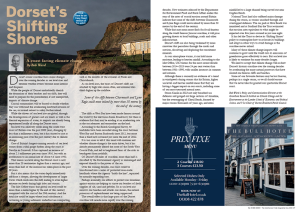A coast facing Climate Change

Dorset’s iconic coastline faces major changes over the coming decades as sea level rises and extreme weather events become more intense and frequent.
While the people of Dorset undoubtedly cherish the dynamism of their beaches and sea cliffs, they will need to prepare for the precedented, if not unexpected, impacts of climate change.
Coastal communities will be forced to decide whether they can withstand the accelerating landward invasion of the sea, or instead retreat to safety further inland.
While the drivers of sea level rise are global, through the disintegration of glaciers and ice sheets as well as the thermal expansion of water, its impacts are already being experienced locally all along the Dorset coast.
Sea level was relatively stable along the south-west coast of Britain over the past 2000 years, changing by less than a millimetre a year, but it has started to rise at an increasing pace over the past century due to climate change.
One of Britain’s longest-running records of sea level comes from a tidal gauge further along the coast at Newlyn in Cornwall. It has captured an increase of about 2.1 millimetres per year since 1916, but with an acceleration to an annual rate of about 4.6 since 1993.
That means sea level along the Dorset coast is now more than 20 centimetres higher than a century ago, and more than half of the increase has taken place in the past 30 years.
But it also means that the water depth immediately offshore is deeper, allowing the development of larger waves which crash into the cliff, leading to even higher extreme sea levels during high tides and storms.
The Met Office warns that global sea level could be more than a metre higher by the end of this century compared with the start of the 20th century. And the total rise could be larger where local subsidence is occurring or young sediments underfoot are compacting, such as the mouths of the estuaries at Poole and Christchurch.
As sea level rises, the bases of Dorset’s cliffs are attacked by high tides more often, and extreme tides climb higher up the rockface.
The cliffs at West Bay have been made famous around the world by the television drama Broadchurch, but there is evidence that they may be eroding at an accelerating rate as the sea advances and encroaches on the land.
According to the British Geological Survey, 40 landslides have been recorded along the coast between West Bay and Burton Bradstock since 2012, but more than a third have occurred just since the end of 2022.
It is too soon to tell if this trend will continue and whether climate change is the main driver, but it has already permanently altered the route of the South West Coastal Path, and led to heightened fears of the risks to beachgoers from rockfalls.
Of Dorset’s 88 miles of coastline, more than half is classified by the Environment Agency as unmanaged and exposed directly to the power of the sea.
Over the coming decades, our coast could be transformed into a series of protected man-made headlands where the Agency “holds the line”, separated by naturally expanding bays.
Perhaps ironically, our efforts to protect our shorelines against erosion are helping to starve our beaches of fresh supplies of silt, sand and pebbles. So as sea level rise narrows our beaches and attacks our shores, the natural processes of replenishment are being suppressed.
The overall effect is that large parts of the Dorset coastline will recede more rapidly over the coming decades. New estimates released by the Department for Environment Food and Rural Affairs earlier this year of the rates of coastal erosion around Britain indicate that some of the cliffs between Charmouth and Lyme Regis could move inland by more than 50 metres by the end of the century.
While that may mean more finds for fossil-hunters along the world famous Jurassic coastline, it will pose growing threats to local buildings, roads and other infrastructure.
Dorset’s cliffs are also being weakened by more rainwater that percolates through the cracks and crevices, dissolving and displacing the constituent minerals.
As our atmosphere warms, it can hold more moisture, leading to heavier rainfall. According to the Met Office, UK winters for the most recent decade between 2014–2023 were 24 per cent wetter than between 1961–1990, with smaller increases in summer and autumn.
Although there is currently no evidence of a trend in windspeeds during storms that hit Britain, higher sea levels and heavier rainfall mean that they are having a bigger impact on our coasts, including some of our most treasured natural areas.
Storm Ciarán in 2023 not only breached sea defences and gouged out large sections of shoreline, but the overtopping of Chesil Beach, formed by major storms thousands of years ago, and extra rainfall led to a large channel being carved out near Cogden Beach.
National Trust land also suffered major damage during the storm, as storms smashed through and overtopped defences. The car park at Hive Beach was inundated and at Studland Bay the Trust estimated that erosion rates equivalent to what might be expected over five years occured in just one night.
It has led the Trust to devise its ‘Shifting Shores’ policy to contemplate how to re-locate its buildings and adapt in other ways to avoid damage as the coastline moves inland.
Many of these climate change impacts will continue to grow until the world cuts its emissions of greenhouse gases effectively to zero. But sea level rise is likely to continue for many decades longer.
We need to accept that climate change will re-draw Dorset’s historic coastline over the coming decades by accelerating the many natural processes that have created our famous cliffs and beaches.
Some of our favourite features may be lost forever, perhaps in a single storm, so we all should ensure that we never take for granted our spectacular Dorset coast.
Bob Ward is Policy and Communications Director at the Grantham Research Institute on Climate Change and the Environment at the London School of Economics and Political Science, and Vice Chair of Burton Bradstock Parish Council.



